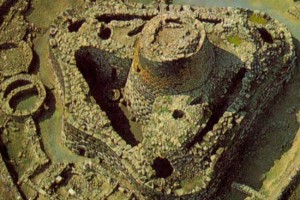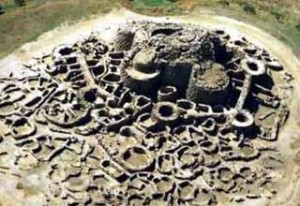Zoltan Ludwig Kruse
Nuraghi *
Nuraghic (Nuragic) is the name given to the ancient culture of Sardinia of the 1st and 2nd millennia BC. The current view is that this  Nuraghic civilisation was devasted by a catastrophe, possibly a tsunami, around 1178-1175 BC.
Nuraghic civilisation was devasted by a catastrophe, possibly a tsunami, around 1178-1175 BC.
The etymology of the name Nuraghe is discussed in some detail by Zoltan Ludwig Kruse on Pierluigi Montalbano’s website(h).
It is characterised by ‘fortifications’ of round towers or nuraghi of which there are still over 7,000 to be seen. Robert Paul Ishoy believes that Atlantis was located on Sardinia and that the Keftiu, Atlantean and Nuraghi cultures were all very closely related(c). Sergio Frau, an Italian journalist, has expressed similar ideas in his well-publicised book [302].
American novelist, Francis Levy, has erroneously claimed(g) that Plato had said that there had been 10,000 towers in Atlantis and consequently “One argument would have it that Sardinia was in fact the lost civilization of Atlantis, which became buried by water when the Mediterranean rose.”
A very interesting site covering the subject of nuraghi structures is noted below(a). The design of the later and cruder giren of Malta (see M. Fsadni’s book[595]) and the bunje of the Adriatic would appear to have derived some inspiration from the nuraghi. Located on the Skellig Rocks off the south-west coast of Ireland are old monastic ‘beehive’ stone huts similar to the ‘giren’. It is also worth mentioning that Robert Bauval photographed a number of towers in the interior of Oman(b) comparable with the ‘nuraghi’.
The El Agujero site on Grand Canary Island would seem to share layout similarities with some of the nuraghi sites. Furthermore, the brochs of Scotland have also been identified as sharing many of the characteristics of the nuraghi, but this is probably just coincidental. If I may digress, many of the brochs were found to have vitrified walls, which to the more imaginative among us suggested ancient atomic warfare(f)! This feature is also to be found in Ireland and mainland Europe(e). A recent study of the Broborg hill-fort in Sweden revealed(d) how vitrification there was achieved, without splitting a single atom.
Ignatius Donnelly also suggested that the Scottish brochs were associated with the nuraghi and goes further suggesting that the round towers of Ireland were the result of similar influences as well as structures in the United States and India, claiming that “it will not do to say that the resemblance between these prehistoric and singular towers, in countries so far apart as Sardinia, Ireland, Colorado, and India, is due to an accidental coincidence.” [1179.418]
It is noteworthy that the nuraghi of the north are generally intact, while those in the south and west are usually found collapsed. In addition, on the Campidano plain in the southwest, there are a number of nuraghes to be found in ‘ooze’ which all point to seismic activity and some inundation. There is obviously more work to be done here.
Giovanni Lilliu has studied the giant broken statues discovered at Monte Prama on the Sardinian Sinis Peninsula and declared them to be nuraghic.
The most extensive of the nuraghi is Su Nuraxi near Brumini, which was only discovered in 1950.
The most dramatic explanation for the construction of so many nuraghi is offered by an American historian, Brian Cairns, who contends that they were built as protection against violent electrical discharges(b)!
(a) Nuraghi: charm in Sardinia 1/6 (archive.org)
(b) Neolithic Man and the Electric Universe – The Thunderbolts Project™ (archive.org) *
(e) https://en.wikipedia.org/wiki/Vitrified_fort
(f) https://ancientnuclearwar.com/
(g) http://www.screamingpope.com/2016/08/sardinia-journal-vii-atlantis.html

